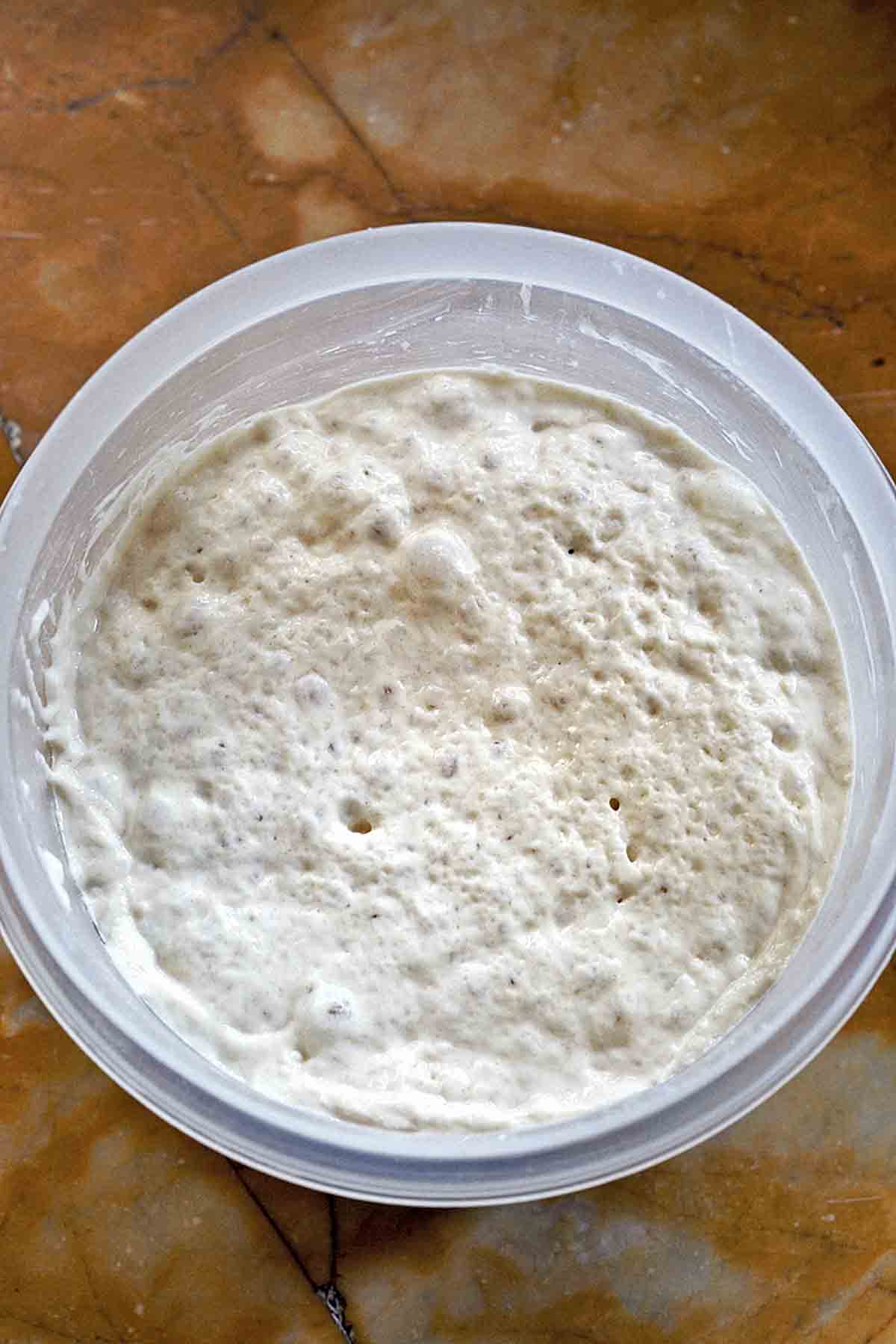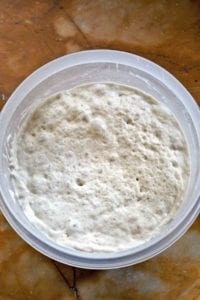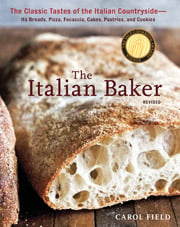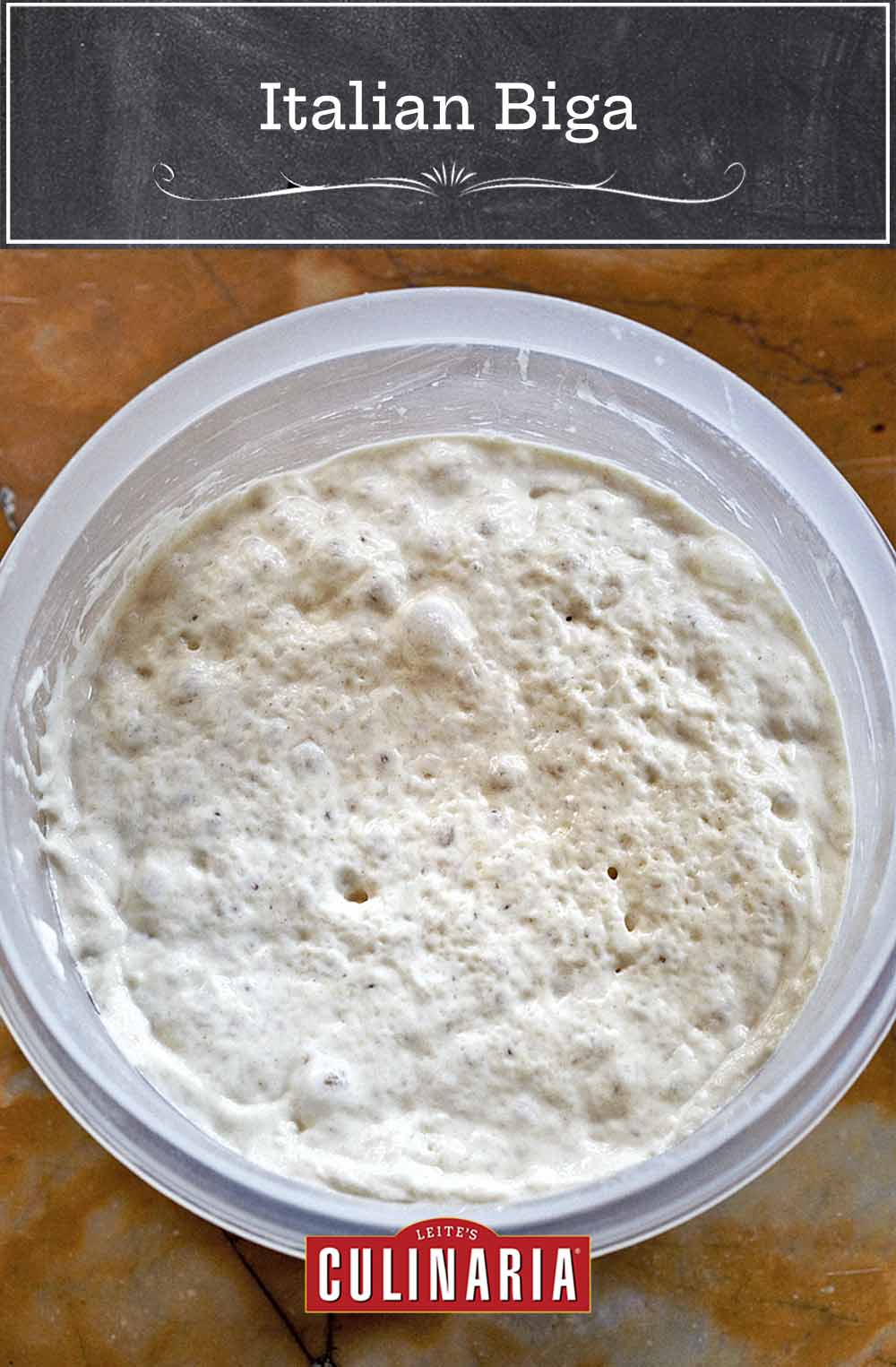
Many of the recipes for classic regional breads, such as this ciabatta recipe, begin with a starter dough made from small amounts of flour, water, and yeast allowed an initial fermentation. The starter, known as biga in Italy, or bighino when in small amounts, not only gives strength to what in Italy are weak flours, it also produces a secondary fermentation from which come the wonderful aroma, natural flavor, and special porosity of the final loaves and wheels of bread.
The important point about a biga is that the breads made with it develop a wonderful taste because their risings are long and bring out the flavor of the grain. Another benefit is that the loaves remain fresher and taste sweeter than those made with large amounts of commercial yeast.
In Italy, bakers use dough from the previous day’s baking to start a new dough. I keep some starter on hand at all times; by having it around, I can decide to make pane pugliese or ciabatta in the morning and have it for dinner that night. Because the first biga must come from somewhere, though, you may make it following the instructions below. It’s remarkable. It freezes very well and needs only about 3 hours at room temperature until it is bubbly and active again, or it can be refrigerated for up to 5 days.–Carol Field
LC Obliged to Biga Note
Behind each and every memorable bite of proper Italian bread we’ve daintily nibbled, hungrily inhaled, or otherwise somehow consumed, we have a biga to thank. So we’re feeling much obliged to Carol Field for this recipe. Nonna not included.

Italian Biga
Ingredients
- 1/4 teaspoon active dry yeast
- 1/4 cup warm water, 100°F to 110°F (38°C to 43°C)
- 3/4 cup plus 4 teaspoons bottled spring water, at room temperature (You can use tap water in a pinch.)
- 2 1/3 cups unbleached all-purpose flour
- vegetable oil, for the bowl
Instructions
- Stir the 1/4 teaspoon active dry yeast into the 1/4 cup warm water and let stand until creamy, about 10 minutes.
- Stir the 3/4 cup plus 4 teaspoons bottled spring water into the creamy yeast mixture, and then stir in the 2 1/3 cups unbleached all-purpose flour, 1 cup at a time. ☞ If mixing by hand, stir with a wooden spoon for 3 to 4 minutes. ☞ If mixing with a stand mixer, beat with the paddle at the lowest speed for 2 minutes. If mixing with a food processor, mix just until a sticky dough forms.
- Transfer the biga to a bowl lightly coated with vegetable oil, cover with plastic wrap, and let rise at cool room temperature for 6 to 24 hours, until the starter is triple its original volume but is still wet and sticky. (The bakers I admire most advise 10 to 11 hours for the first rise, but others are very happy with the 24 hours it takes for dough to truly become yesterday’s dough, and if you like sour bread, allow your biga to rest for 24 to 48 hours or even 72 hours.)
- Cover and refrigerate or freeze the biga until ready to use. (If refrigerating the biga, use within 5 days. If freezing the biga, let it rest at room temperature for about 3 hours until it is bubbly and active again.) When needed, scoop out the desired amount of biga for your recipe and proceed. I strongly recommend weighing the biga rather than measuring it by volume since it expands at room temperature. If measuring by volume, measure chilled biga; if measuring by weight, the biga may be chilled or at room temperature.

Nutrition
Nutrition information is automatically calculated, so should only be used as an approximation.
Recipe Testers’ Reviews
This is a perfectly suitable starting point for most any bread which uses a starter. I bake bread several times a week and it’s nice to have this handy. Sometimes I add this to a bread dough which doesn’t call for a starter just for the added flavor.












Hi, I made the biga this am, and though it is rising slowly, it is absolutely not wet. It looks like a traditional yeast dough rising, before shaping and rising a 2nd time. Will it be ok to proceed with the ciabatta recipe?
Hi Christina, I would go ahead and use the biga. Please let us know how the ciabatta turned out.
Ken Forkish (look him up) makes his biga at 68% hydration. It is a bit on the dry side initially but when you start with his pincer mixing, it quickly comes together (bit sticky but very “stretchy”). This one at 78% should be very loose and quite sticky. It’s only going to be dry when the water is first added. It will thoroughly mix and become sticky quite quickly. When left for the 12-18 hours, it will literally be 3x to 4x the original size and super super bubbly. I can only surmise that you measured the water or the flour incorrectly. I’ve made dozens of the Forkish version (this biga version one is wetter) and after comparing the two recipes, I know this ciabatta biga recipe is correct. The biga does not look like traditional dough after the 12+ hours while it ferments. It is a big, jiggly (literally) bubbly mass of dough. The gluten strings are simply amazing to see.
I keep my oven temps (where I let it ferment) at a constant 70o F the whole 12+ hours.
Thanks for that, Len D.
Can I use biga if it’s been in the refrigerator for more than 5 days?
Dar, I consulted with our bread baking expert, Cindi Kruth, who is a recipe developer and baking instructor. She has the following to say… “Yes, the biga can be refrigerated for several days. It is, essentially, just a starter made with commercial yeast instead of wild yeast. The recipe even says it can be refrigerated up to 5 days. I usually feed my starters again if it’s been several days, but if the reader is using it in a recipe has additional commercial yeast (such as the ciabatta) that’s not necessary. If there is commercial yeast then the starter is basically being used for flavor and keeping qualities, not for leavening. If there is no other yeast in the recipe then I’d advise feeding the starter once or twice on the day of use until it is active and bubbly again. “So sounds like it’s a go!
Recently began bread making because I found much info about ’18-hour, no-knead bread,’ but found the usual recipes flat on flavor until I found your recipes for Biga/Ciabatta. So made the Biga, rested it for 24 hours, then added it to your Ciabatta dough recipe…. and then let the combined Ciabatta with Biga dough rest for 18 hours. Turned out well, fine taste and texture. Now wondering if I can cut out 1 step: for the 18-hour-rise method, would I just double your Biga recipe and let it rest for 18 hours and bake.. OR — would I combine the Biga and Ciabatta recipes and let that rest for 18 hours. Thanking you in advance.
Hi Linda, think of the biga as a flavorful starter. It works in combination with other doughs.